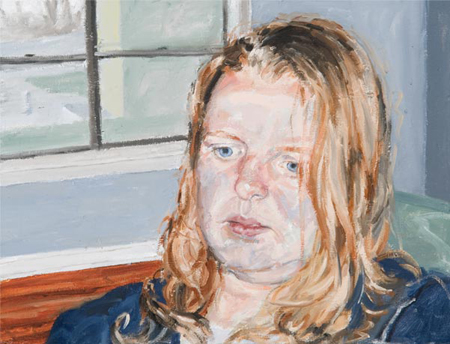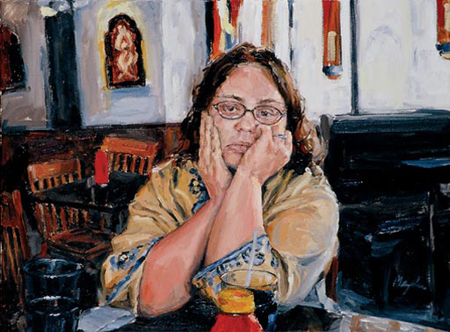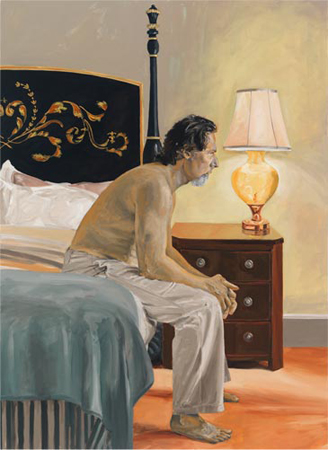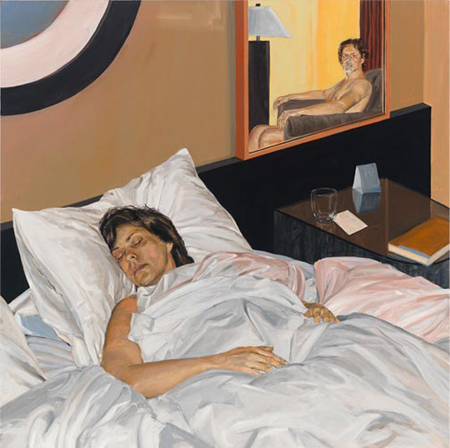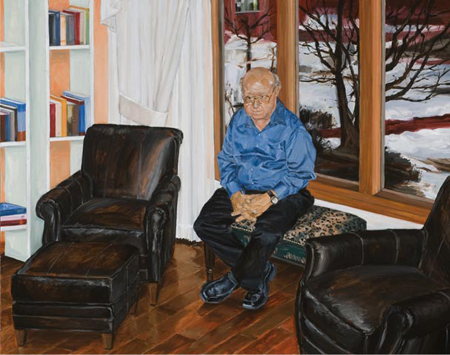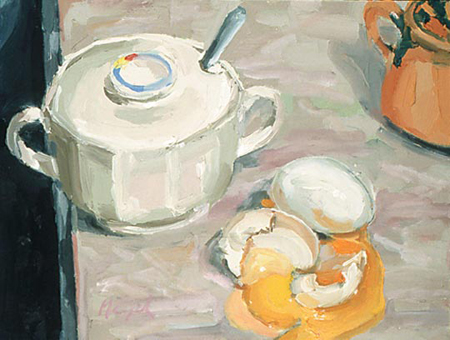Norbert Marszalek has been living and working in Chicago for all of his painting career. He has shown at the George Billis Gallery in Los Angeles and has exhibited in solo and group exhibitions in museums and galleries throughout the United States. He handles paint in his emotionally charged portraits a little like the British artist Jenny Saville’s lush dichotomy of realism and abstraction.
I have only corresponded with Norbert online through his blog, Neoteric Art, which I found in 2008 when I first began my own. He always showcases thoughtful and informative posts on the arts.
Phoenix Bound. Oil on canvas, 13″ x 17″ 2007
Dialogue No. 4. Oil on canvas, 18″ x 24″ 2003.
What led you to become a painter?
NM Drawing and painting have always been a part of my life. My brother’s art books were around the house and I remember poring over them with great enthusiasm at a very young age—I was around six or seven years old. I was in awe of Edward Hopper’s Nighthawks, George Bellow’s Stag at Sharkey’s and Pablo Picasso’s The Old Guitarist. I really enjoyed the “storytelling†aspect of those particular paintings. At that same time I started drawing. I copied comic strip figures, sports figures—typical childhood stuff. As I got older I experimented more with drawing and painting and fully realized in my late teens that this is what I wanted to do with my life.
Can you describe how Chicago or the region influences (or doesn’t) your work?
NM The first time I became aware of an actual Chicago scene was with the Imagists—Ed Paschke, Roger Brown, Barbara Rossi, etc.—in the early 1980s when I was in college. The Imagists seemed too “popish†for me so it gave me something to rebel against (kids always need to rebel, right!?). I actually admired Eric Fischl and the German Neo-Expressionists that were gaining popularity. I guess I have always been drawn to figure work. Later I came to respect the Imagists and the preceding movements, The Monster Roster and The Hairy Who with immense fondness.
Overall, we are all influenced by our surroundings…how can you not be? To answer your question though, I am influenced by Chicago in more of a “working class†sort of way. I come from a working class family—my father was in construction, then became a butcher, bartender and ended up in a factory. It has to do with work ethic and a little of those Midwestern values thrown in. I’m sure it’s reflective in my work.
DC Hotel Room. Oil on canvas, 48″ x 60″ 2009.
Describe your daily painting/working routine and what inspires your paintings? Do you make sketches or draw on a regular basis?
The routine is just about going to the studio and painting. I’ve been painting in series now for many years so I have blocks of 2-3 years while I am working out the series. I really don’t see it as a “daily†routine but more as a “series†routine.
I just completed a series called Hotel Room Paintings which I started in 2009 and have been contemplating the aspect of just making paintings and not working in a series. I’m sure I’ll be more conscious of a “daily†routine. We’ll see what happens.
Totem Hotel Room. Oil on canvas, 48″ x 35″ 2011.
Triad Hotel Room. Oil on canvas, 52″ x 52″ 2011.
Do you paint from life or photographs, or both? If from both, is there much difference in your process?
As a mature painter I have always used photography for reference (of course back in college there was a lot of drawing and painting from life). Not stock photography but my own. I would set up a scene and shoot (or have an assistant shoot if I was in the scene) various angles and perspectives and then take maybe 5-7 of those photos and make a comprehensive sketch—work out the composition. I would even photograph still life scenes and go through the same ritual. I then sketch out the canvas with charcoal—I never project the image—and begin to really flesh out the composition using oil paint. Again, the photographs and sketch are just for reference. I usually make changes as needed as I paint.
As I have stated in my previous answer about not working in series, I also plan on not using photography for reference. It seems like I am in a transitional period. I have presently attempted a few still life paintings painting from the actual items. I really don’t see a difference between using photographs and painting from life.
I see Hopper and Eric Fischl in some of your interiors and a little Alice Neel in a few of your figurative works. Can you talk about the context of your work and any ideologies you may have as an artist?
Well, I have mentioned Hopper and Fischl already in this interview and I really do like Alice Neel so it makes sense that you see their influence in my work. I’m aware of it too—especially Fischl. As artists, we eventually gravitate toward a personal style, whatever it may be. I like brushwork that has immense energy but is still controlled—like George Bellows. Fischl doesn’t have all that energy but there is a sense of urgency which I really like. And then there is Lucian Freud. I’m trying to find a balance with all of that with my own style—energy, urgency, control. I’m getting closer.
Storytelling also plays a role in my work. I am all about the narrative. I’m sure that’s why I paint in series. It’s like writing a novel. My series have a beginning, middle and end but it may not be totally linear. Besides the literal “story†of each canvas, the entire process of creating each series is a “story†unto itself. With each series I find myself entering a journey and I record it using the canvases. It feels like it has culminated with the Hotel Room Paintings series…I’m sure that’s why I’m in flux right now.
Waiting and Waiting for Nothing. Oil on canvas, 39″ x 49″ 2008.
Which artists have had the most influence on your work? And are there current painters whose work excites you?
Besides the painters I have already mentioned (plus a plethora of others) I remember the first time I became introduced to the work of Willem de Kooning. It was back in college with his painting Gotham News. As they say, you could have knocked me over with a feather. I was familiar with abstraction and abstract expressionism in general but the timing was right for me to really “experience†it. The explosiveness, the energy, the power—it’s a feeling that I have taken with me and have never forgotten.
As far as current painters, there are also too many to mention but I do really like the work of Wesley Kimler  here in Chicago and Ruprecht von Kaufmann  in Berlin.
Some artists suggest that the studio is too private for them, that they require a social forum for their work. Does networking with other artists and developing community have much bearing on your life as an artist and if so, how does it inform your work and process?
I enjoy the solitude of the studio but I do enjoy getting my work out—I want it to be seen. I interact with other artists but that doesn’t influence my work. The interactions are more about the art scene, gossip, news, etc. The community aspect of the art world is important. Artists should talk with each other more—share ideas, goals, dreams. etc.
Still Life With Yolk. Oil on canvas, 12″ x `16″ 2001.
I’m always curious about how painters are utilizing social networking. You have maintained a blog for a few years and offer interviews with other artists and you also post quite a bit on Facebook. I know painters who have been successful marketing their work online, even while they’re represented by a gallery. Have you explored some of these or other alternative ways to either exhibit or sell your work?
Another painter, William Dolan, and I started Neoteric Art  over 3 years ago. We consider it more like an e-zine. It’s a way for us to vent on a specific topic, give other artists a platform and most importantly it’s been a great way to meet others in the art world. It has opened up doors. Neoteric Art was recently part of the Midway Fair here in Chicago, which was a really interesting event. We don’t use it to promote ourselves directly but it does help to get our names out there. Facebook is another way to meet others and do some soft promoting. You want to make sure that you don’t over use it though.
I have not sold any work via online networking yet but I do see that being a potential market one day very soon. I also know others who sell a lot of work online. I don’t see the gallery system being as bankrupt as recent discussions have eluded to but hey, whatever works to get the work out there.
This next question may dovetail with the previous one; are you able to make a living solely from your painting, or do you work a ‘day’ job?
I have a day job that I keep completely separate from my painting (though my day job is art related and I really enjoy it). It is extremely difficult to survive as a “real†painter. I commend artists that are able to do it. There is a lot of financial sacrifice that comes with the territory and even though I have a day job I still feel the financial stress myself.
Any immediate plans for exhibits and/or the next series of work?
I’m in line for an artist residency at the end of the year and some galleries are biting at the Hotel Room Paintings so things are going well. And as I have said I am somewhat in a transitional period with my work right now. I am going to lay off the “series†and just paint individual type paintings. A series may emerge…we’ll see. Let me put it this way…instead of painting a novel I will be painting short stories.

